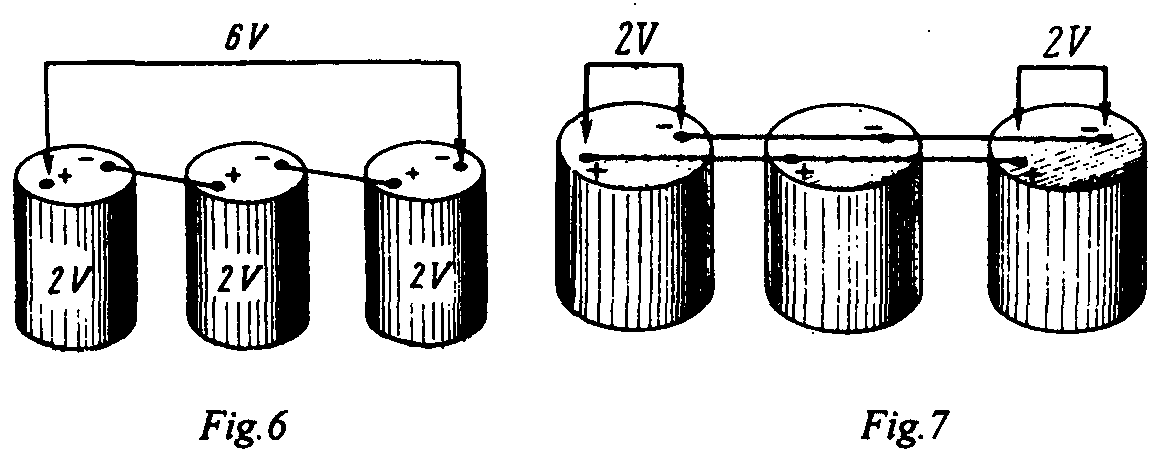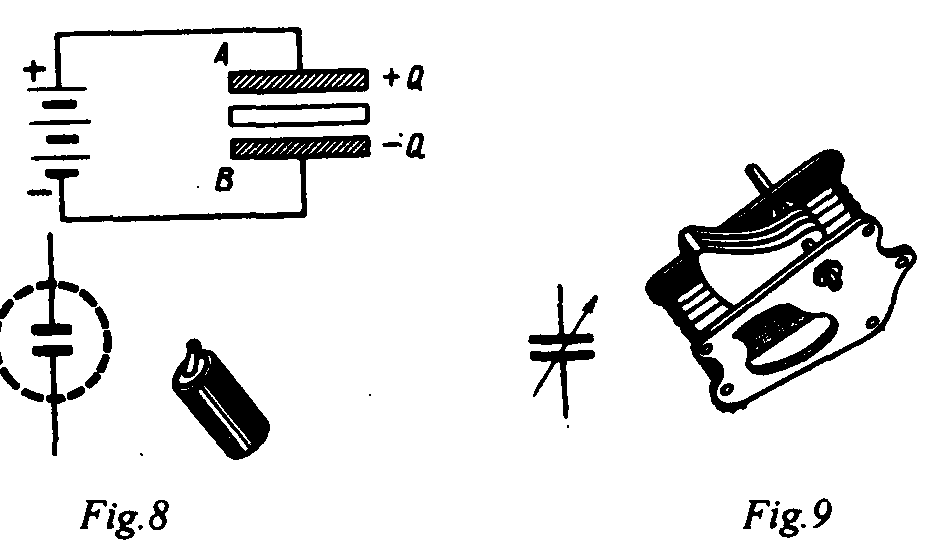
- •1. Electric Circuit. (Unit 5)
- •2. Series Circuit and Parallel Circuit. (Unit 6)
- •3. Meters. (Unit 7)
- •4. Resistor. (Unit 8)
- •5. Electric Cells. (Unit 9)
- •6. Capacitors. (Unit 10)
- •7. Conductors and Insulators. (Unit 11)
- •8. Transformers. (Unit 12)
- •9. Types of Current. (Unit 13)
- •10. Inductance and Mutual Inductance. (Unit 14)
- •11. Coupling . (Unit 15)
5. Electric Cells. (Unit 9)
An electric cell is used to produce and supply
electric energy. It consists of an electrolyte and two electrodes.
Electrodes are used as terminals, they connect the cell to the
circuit – current passes through the terminals and the bulb lights.
Cells can be connected in series. In parallel and in series-parallel. In order to increase the current capacity cells should be connected in parallel. In order to increase the voltage output cells should be connected in series. In case a battery has a large current capacity and a large voltage output, its cells are connected in series-parallel.
When cells are connected in series the positive terminal of one cell is connected to the negative terminal of the second cell, the positive terminal of the second cell-to the negative terminal of the third … and so on.

When cells are connected in parallel their negative terminals arc connected together and their positive terminals are also connected.
In case a cell has a trouble it stops operating or operates badly. This cell should be substituted by another one.
6. Capacitors. (Unit 10)
A capacitor is one of the main elements of a circuit. It is used to store electric energy. A capacitor stores electric energy provided that a voltage source is applied to it.

The main pars of a capacitor are metal plates and insulators. The function of insulators is to isolate the metal plates and in this way to prevent a short.
In the diagram one can see two common types of capacitors in use nowadays: a fixed capacitor and a variable one. The plates of a fixed capacitor cannot be moved; for this reason its capacity does not change. The plates of a variable capacitor move; its capacity changes. The greater the distance between the plates, the less is the capacity of a capacitor. Variable capacitors are commonly used by radiomen; their function is to vary the frequency in the circuit. Fixed capacitors are used in telephone and radio work.
Fixed capacitors have insulators produced of paper, ceramics and other materials; variable capacitors have air insulators. Paper capacitors are commonly used in radio and electronics their advantage is their high capacity: it may be higher than 1,000 picofarad.
Besides, electrolyte capacitors are highly in use. They also have very high capacity: it varies from 0.5 to 2,000 microfarad. Their disadvantage is that they change their capacity when the temperature changes. They can operate without a change only at temperatures not lower than –40 C.
Common troubles in capacitors are an open and a short. A capacitor stops operating and does not store energy in case it has a trouble. A capacitor with a trouble should be substituted by a new one.
7. Conductors and Insulators. (Unit 11)
Conductors are materials having a low resistance so that current easily passes through them. The lower the resistance of the material, the more current can pass through it.
The most common conductors are metals. Silver and copper are the best of them. The advantage of copper is that it is much cheaper than silver. Thus copper is widely used to produce wire conductors. One of the common functions of wire conductors is to connect a voltage source to a load resistance. Since copper wire conductors have a very low resistance a minimum voltage drop is produced in them. Thus, all of the applied voltage can produce current in the load resistance.
It should be taken into consideration that most materials change the value of resistance when their temperature changes.
Metals increase their resistance when the temperature increases while carbon decreases its resistance when the temperature increases. Thus metals have a positive temperature coefficient of resistance while carbon has a negative temperature coefficient. The smaller is the temperature coefficient or the less the change of resistance with the change of temperature, the more perfect is the resistance material.
Materials having a very high resistance are called insulators. Current passes through insulators with great difficulty.
The most common insulators are air, paper, rubber, plastics.
Any insulator can conduct current when a high enough voltage is applied to it. Currents of great value must be applied to insulators in order to make them conduct. The higher the resistance of an insulator, the greater the applied voltage must be.
When an insulator is connected to a voltage source, it stores electric charge and a potential is produced on the insulator. Thus, insulators have the two main functions:
1. to isolate conducting wires and thus to prevent a short between them and
2. to store electric charge when a voltage source is applied.
